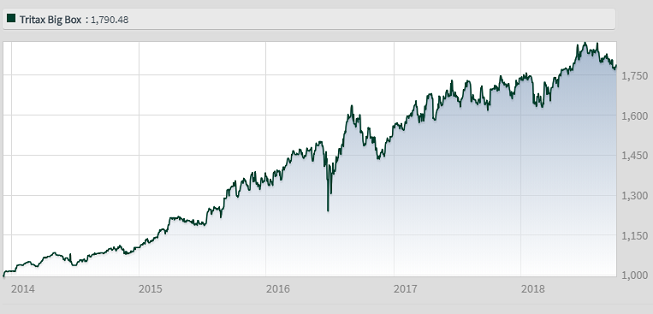Stockwatch: A defensive high-yielder to buy
2nd October 2018 10:06
by Edmond Jackson from interactive investor
Share on
This specialist property investor has been a successful tip and looks like it can withstand macro risks, argues Edmond Jackson who still thinks they're worth owning.

What confidence is there in commercial property, especially for defensive investment, if the economic context is deteriorating? Martin Feldstein – Professor of Economics at Harvard and a past adviser to Ronald Reagan – has joined those I noted in last week's macro piece, warning that the trend to higher interest rates will burst global asset bubbles inflated by monetary stimulus.
The US is particularly exposed given the Trump Administration's tax cuts, coming late in one of the longest up-cycles in history, stoking inflation risks the Federal Reserve will need to contain. While the UK is an ocean apart, and our central bank remains too edgy over Brexit to raise interest rates, financial change in the US usually ripples out.
Premium to net asset value (NAV) has recently eroded
In which respect the mid-cap shares of real estate investment trust Tritax are a pertinent study.
I've drawn attention various times to Tritax, an investor/developer of warehouses serving major supermarkets and the digital economy, since 105p in June 2014, with a sense to "buy the dips" in recent years.
Since last July market price has fallen from 157p to 148p currently, so does the same apply? While a 4.5% prospective yield isn't as exciting as some income stocks, it's relatively high quality given the shift in retail towards the digital economy that such warehouses serve, plus for essential food items.
Moreover, the stock is well backed by assets, if we can be reasonably sure their value is sustainable. First-half 2018 results showed NAV per share – on a European Real Estate Association (EREA) basis – up 2.8% to 146.2p over 12 months, compared with balance sheet net tangible assets per share up 9.9% to 145.4p on a diluted basis.

Source: interactive investor Past performance is not a guide to future performance
The medium-term context of market premium erosion is shown by Tritax shares reaching 148p two years ago after the 2016 interims declared EREA NAV of 128.9p. A near 15% premium likely reflected optimism about the business model in an assets market still benefiting from cumulative QE and ultra-low interest rates.
Despite the Tritax story remaining promising, holders have only really benefited from a 4%-plus yield in two years, hence a less-strong technical position nowadays as private investors look for something more exciting.
Discounts to NAV are the norm anyway
Discounts are typical, such is the default rating for property investment stocks, the exceptions being an innovative business model well-suited to the times, and modest company size to help boost growth. For long-term "reversion to the mean" not to apply as property companies mature, they need something truly special.
Tritax's unique selling point is a focus on assets likely to continue to grow in demand over the medium term, and be resilient unless developers create over-supply. By contrast, Land Securities shares trade around a 37% discount to net asset values given it's a £6.6 billion FTSE 100 company (versus £2.2 billion for Mid 250 Tritax) and its rental income is diversified across UK offices, shopping centres and retail parks – the kind of sectors exposed to domestic slowdown and retail's shift online.
Analysts still expect a profits recovery in Land's current financial year to March 2019, with a projected yield of about 5.2% against a current stock price around 880p, making it an interesting comparison with Tritax in terms of risk/reward.
Yet bullish expectations continue for UK warehouses
Recent surveys appear encouraging for Tritax shareholders. Last June, Savills noted:
"the UK retail warehouse sector delivered the strongest annual rental and capital value growth (4.3% pa and 4.6% pa respectively) of any commercial property sector over the 1980-2017 period"
– evolving from bulky goods/DIY on outskirts of towns/cities, to retail parks which saw annual rental growth averaging 11.3% between 1985 and 1990.
Shopping parks subsequently enjoyed 5.4% between 2000 and 2006, helped by keen demand from institutional investors, although an inflection point was hit in 2005-06 (i.e. well before the financial crisis) with the vacancy rate rising from under 6% to nearly 12% by 2009 – when receivership's kicked in.
• A quality income play to start 2018
• Stockwatch: "Steady income" opportunities at Tritax
Such a shake-out would appear less likely for the kind of discount retailers in general merchandise and food, driving demand for warehouse space in the last five years - i.e. Tritax's period of existence -
"which has helped reduce the vacancy rate to record low levels... however their low price model means margins are thin, and thus while activity has been robust their willingness to pay higher rents has been muted."
This explains why I'd be steeled for Tritax's upward-only rent reviews eventually to get challenged. They seem durable for so long as demand/supply of warehouses does not hit an inflection point like other retail property concepts have.
More positively, Lambert Smith Hampton, a national property consultancy, argues:
"demand for logistics warehouses will exceed UK stock by 25m sq ft by 2020 – even if current elevated levels of new development continue."
This would push out any inflection point, implying Tritax shares merit holding despite a sea-change in interest rates underway, liable to undermine asset values generally. E-commerce in the UK is not just growing rapidly; it's evolving as retailers compete to satisfy consumer demand ever more quickly and efficiently.
A significant and unprecedented increase in construction will be required in the next few years to ensure internet retailers are able to continue to fulfil their customer orders."
It all implies a sweet spot, limited chiefly by land availability. Tritax's strategic land purchases are limited to 10% of the group's net asset value, the last principal one being a year ago – of a 114 acre, former power station site at Dartford.
| Tritax Big Box REIT - financial summary | ||||||
|---|---|---|---|---|---|---|
| year ended 31 Dec | 2014 | 2015 | 2016 | 2017 | 2018 | 2019 |
| Turnover (£ million) | 16.4 | 45.2 | 76.9 | 285 | ||
| IFRS3 pre-tax profit (£m) | 35.9 | 134 | 91.9 | 248 | ||
| Normalised pre-tax profit (£m) | 35.9 | 27.2 | 44.4 | 200 | 104 | 104 |
| Operating margin (%) | 243 | 77.2 | 79.0 | 77.2 | ||
| IFRS3 earnings/share (p) | 12.9 | 21.5 | 10.5 | 10.5 | ||
| Normalised earnings/share (p) | 12.9 | 4.4 | 5.1 | 5.7 | 7.6 | 7.6 |
| Price/earnings multiple (x) | 26.0 | 19.4 | 19.4 | |||
| Cash flow/share (p) | 6.7 | 3.4 | 6.9 | 6.8 | ||
| Dividends per share (p) | 2.9 | 3.8 | 7.7 | 6.4 | 6.7 | 6.9 |
| Yield (%) | 4.3 | 4.3 | 4.5 | |||
| Covered by earnings (x) | 4.4 | 1.3 | 0.8 | 1.2 | 1.1 | 1.1 |
| Net tangible assets per share (p) | 107 | 124 | 128 | 141 | 143 | 150 |
| EPRA NAV per share (p) | 108 | 125 | 129 | 142 |
Source: Company REFS Past performance is not a guide to future performance
Market technical position looks quite tired...
The stock slipped in August despite strong interims, and has barely moved in response to 28 September news of a circa £68 million development of a new logistics facility at Merseyside. That reflected a net initial yield of 4.9%, rising to 5.4% at the first rent review in 2024.
It appears the story is respected by Tritax's institutional investor fan-base, while private investors suspect the stock will mark time around NAV. Corporate size is likely involved too, deals nowadays being incremental for advancing NAV.
It will be interesting to see how they get financed given a placing discount to market price would currently also involve a discount to underlying value. One last April at 142.5p raised £155.6 million gross, representing 8% of the pre-placing share capital.
Tritax's balance sheet could support more debt at the risk of being seen an odd move if long-term interest rates are at a turning point. June-to June debt was cut by a refinancing from £673 million to £207 million (all long-term) though cash also fell from £467 million to £105 million. The context is £2,144 million net assets, within which investment property constituted £2,755 million.
It's unsurprising then, Tritax has just announced a new £250 million near-term banking facility "for committed capital at an attractive margin, to assist with acquisitions in its strong investment pipeline". The term can be extended from 12 to 18 months, as if this is mainly a stop-gap to avoid dilution.
Yet offers a fresh buy for defensive qualities
Tritax remains interesting as one means to buttress an investment portfolio against macro risks. For the next few years, structural shifts in UK retailing appear to underwrite the company given its focus: any market dip below circa 147p underlying net asset value/share will push the yield towards 5% while rents remain protected.
On a two-year view, the stock therefore looks useful for defensive positioning, I believe "buy the dips" does still pertain. Those without a holding may therefore want to consider: Buy.
Edmond Jackson is a freelance contributor and not a direct employee of interactive investor.
These articles are provided for information purposes only. Occasionally, an opinion about whether to buy or sell a specific investment may be provided by third parties. The content is not intended to be a personal recommendation to buy or sell any financial instrument or product, or to adopt any investment strategy as it is not provided based on an assessment of your investing knowledge and experience, your financial situation or your investment objectives. The value of your investments, and the income derived from them, may go down as well as up. You may not get back all the money that you invest. The investments referred to in this article may not be suitable for all investors, and if in doubt, an investor should seek advice from a qualified investment adviser.
Full performance can be found on the company or index summary page on the interactive investor website. Simply click on the company's or index name highlighted in the article.